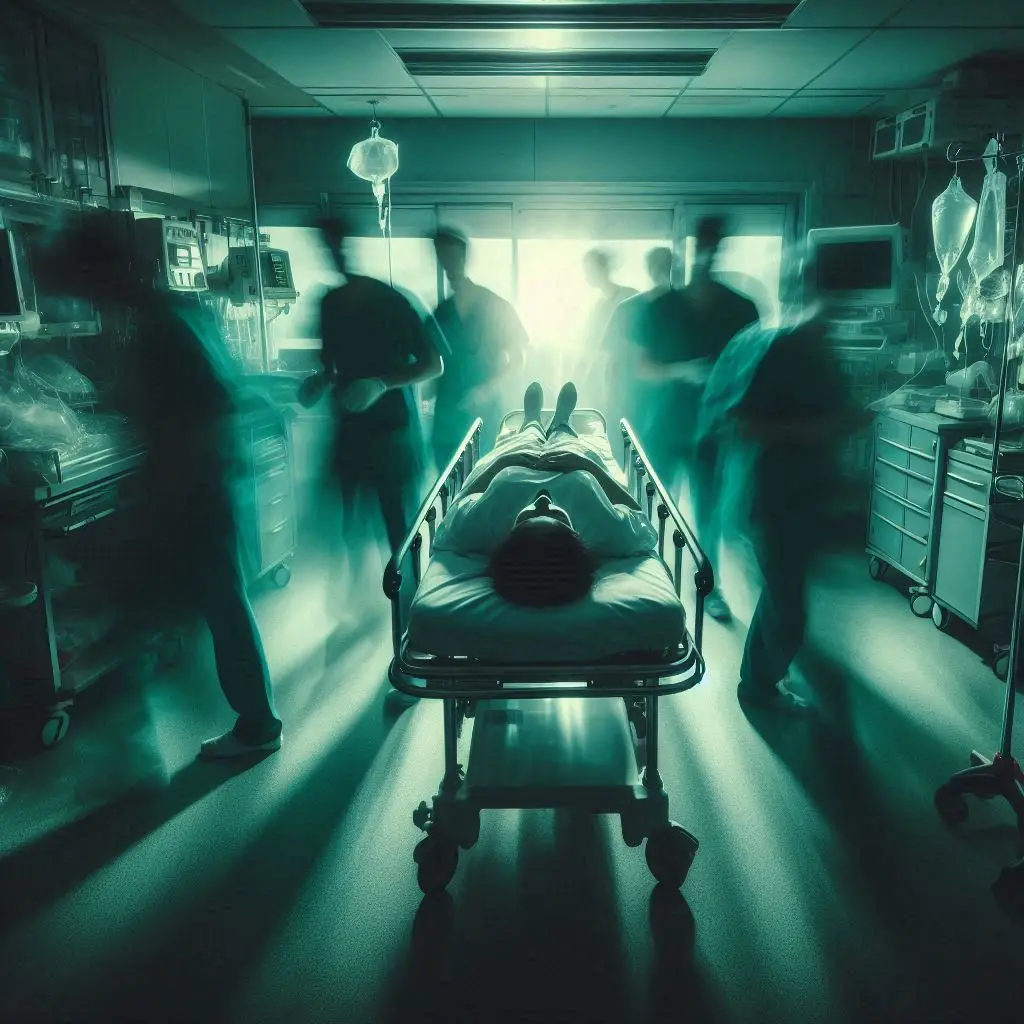Imagine being rushed into a hospital emergency room. You’re gasping for breath, your body trembling with pain. Doctors and nurses swarm around you, trying to save your life. And then… one by one, those very doctors and nurses start collapsing. They faint, vomit, and struggle to breathe.
It sounds like something out of a horror movie. But this really happened.
In 1994, in Riverside, California, a woman named Gloria Ramirez came to the hospital in critical condition. What happened over the next few hours would baffle doctors, terrify staff, and eventually earn her a haunting nickname: The Toxic Lady.
This is the strange, dark, and mysterious story of a patient whose very body seemed to poison those who tried to help her.
The Night of February 19, 1994
It was a chilly Saturday night at the Riverside General Hospital. The emergency department was busy, but nothing unusual—broken bones, flu cases, chest pains. Then, just after 8 p.m., paramedics wheeled in a woman in her early thirties.
Her name was Gloria Ramirez, a 31-year-old mother of two. She was suffering from late-stage cervical cancer. That night, she had started experiencing severe breathing problems and confusion at home. Her family called an ambulance, and now she was barely conscious, gasping for air, with her heart racing out of control.
Doctors and nurses immediately began emergency treatment. They gave her oxygen, injected medications, and tried to stabilize her heartbeat. At first, it seemed like a normal, though serious, medical crisis.
But then… things got strange.
The First Signs
One of the nurses, Susan Kane, prepared to draw Gloria’s blood. She inserted a needle, attached a syringe, and pulled back. But as soon as the blood began to flow, Susan froze.
The blood wasn’t normal.
She later described it as looking oily. It had an odd texture, as if it were thicker than usual. And there was something else—a strange chemical smell. Susan said it reminded her of ammonia.
She handed the syringe to another nurse, Julie Gorchynski, who leaned in to take a closer look. Julie sniffed the sample cautiously. “It smells weird,” she said. Then she noticed small crystalline particles floating in the blood, like tiny shimmering flecks.
Doctors exchanged uneasy glances. Something wasn’t right.
And then… chaos erupted.
The Collapse
Suddenly, nurse Susan felt dizzy. The room seemed to spin. She whispered that she didn’t feel well—and then she collapsed onto the floor.
Julie, the nurse who had examined the blood, felt a wave of nausea and faintness. Moments later, she also collapsed.
Then, the third staff member, Dr. Julie Korchinski, slumped over, unable to breathe properly.
One by one, six people treating Gloria Ramirez fell ill. They staggered, vomited, fainted, or lost control of their muscles. The emergency room turned into a disaster scene.
Staff members panicked. Some thought there was a chemical leak in the hospital. Others feared they had been poisoned. A code orange was declared—meaning a hazardous materials situation.
Doctors scrambled to evacuate the ER. Patients were wheeled into hallways. Staff staggered outside, gasping for fresh air. The emergency room, meant to be a place of healing, was now contaminated.
And at the center of it all was Gloria Ramirez.
A Death in the Middle of Mystery
While the staff struggled, Gloria’s condition worsened. Despite efforts to save her, her blood pressure dropped, and her heart faltered. At 8:50 p.m., just 35 minutes after she had arrived, Gloria Ramirez was pronounced dead.
She was only 31 years old.
But her death didn’t end the nightmare. Instead, it deepened the mystery.
Because the question wasn’t just why Gloria had died. It was: What on earth had happened to the people trying to save her?
The Fallout
In total, 23 people who had been in or near the ER that night experienced strange symptoms. Five required hospitalization. One nurse spent two weeks in intensive care, struggling with respiratory problems. Another developed hepatitis-like symptoms and bone marrow issues.
This wasn’t just fainting from stress. Something real, something physical, had poisoned the medical team.
But what?
The Investigation Begins
The case exploded into national headlines. Newspapers called Gloria Ramirez The Toxic Lady. TV anchors described the hospital scene as a “medical X-Files.”
The coroner’s office launched an investigation. Scientists from multiple agencies swarmed the hospital. They examined the air, the equipment, and Gloria’s body.
Theories flew everywhere.
Some thought Gloria had been poisoned by pesticides or industrial chemicals. Others suspected a rare reaction between her medication and her cancer. Some even whispered about government cover-ups, secret chemical weapons, or alien infections.
The truth was elusive—and stranger than fiction.
The First Explanations
One early theory was mass hysteria. Psychologists suggested that maybe the staff had panicked, and their fainting and nausea were psychological, not physical.
But the problem with that explanation was the evidence. Several staff members had real, measurable medical damage—liver problems, reduced white blood cell counts, and lasting health issues. You can’t get those from stress or panic. Something had poisoned them.
So investigators dug deeper into Gloria’s body. And that’s when they found a bizarre clue.
The Chemical Puzzle
Toxicologists discovered strange compounds in Gloria’s tissues. Specifically, they found evidence of dimethyl sulfone, a chemical related to a household substance called dimethyl sulfoxide (DMSO).
Here’s where it gets weird: DMSO is a solvent that some people in the 1990s used as an alternative home remedy for pain. You could buy it in hardware stores. It was sometimes rubbed on the skin. Some believe Gloria, who was battling late-stage cancer, may have been using it to ease her pain.
The theory is that Gloria applied DMSO to her skin. When paramedics gave her oxygen in the ambulance, the chemical reacted in her body and converted into dimethyl sulfone. Then, under the intense conditions of the ER—oxygen, drugs, and defibrillator shocks—it may have transformed again into dimethyl sulfate, a highly toxic gas.
Dimethyl sulfate can cause fainting, seizures, respiratory failure, and organ damage—the exact symptoms seen in the ER staff.
It was a chilling possibility: Gloria’s own body may have become a chemical factory, releasing poison gas as doctors worked on her.
Controversy
But not everyone accepted this explanation. Some scientists argued the evidence wasn’t strong enough, and the chemical reactions seemed unlikely inside a human body. Others stuck to the mass hysteria theory, claiming stress and suggestion had caused the staff’s collapse.
Even today, the case is unsolved. No single explanation has ever been universally agreed upon.
What remains certain is that something very real happened in that ER on February 19, 1994. Something that turned a routine medical emergency into one of the strangest toxic mysteries in history.
The Legacy of the Toxic Lady
After her death, Gloria Ramirez was buried in Riverside, her grave marked simply with her name and dates. For her family, the tragedy wasn’t the mystery—it was the loss of a young mother, taken too soon by cancer and remembered only for the bizarre events surrounding her final hours.
For science, her case remains a haunting puzzle. Was Gloria using a simple pain cream that turned deadly? Did doctors and nurses inhale toxic gases created inside her body? Or did fear and panic ripple through the ER, creating symptoms so powerful they left lasting scars?
We may never know.
Why This Story Matters
The case of Gloria Ramirez is terrifying because it shows how quickly the ordinary can become extraordinary. She went to the hospital for help, but her body became the center of chaos. Doctors and nurses—the very people sworn to heal—were knocked down simply by trying to save her.
It’s also a reminder that science doesn’t always have neat answers. Even today, decades later, researchers still argue about what really happened. Sometimes, real life is stranger than fiction.
Closing
On that February night in 1994, Gloria Ramirez became more than just a patient. She became a mystery—The Toxic Lady.
Doctors still can’t agree whether her body produced poison gas, whether chemicals interacted in some freak accident, or whether mass hysteria swept through the ER.
What we know for certain is this: when Gloria Ramirez entered the hospital, she set off a chain of events so bizarre and so disturbing that decades later, we’re still talking about it.
And maybe that’s the most chilling part. Because if it happened once… could it happen again?
That is the strange, dark, and mysterious story of Gloria Ramirez—the Toxic Lady.




